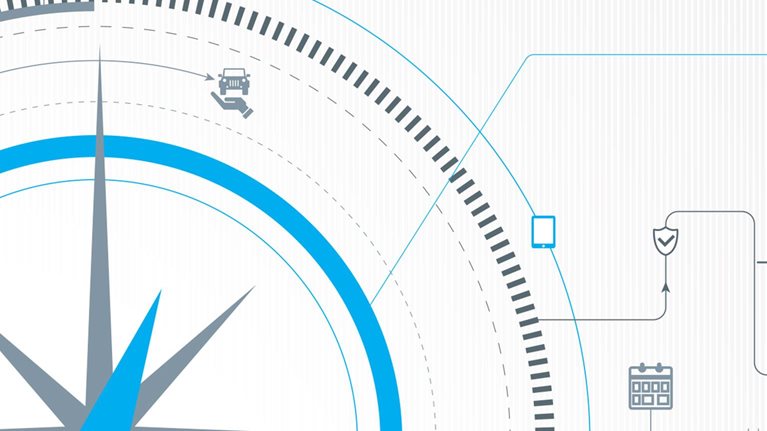The insurance industry is facing a serious structural challenge. While some lines of business have seen years of steady top-line growth, life insurance carriers in mature markets have been particularly hard hit by the low interest environment. As a consequence, the majority of carriers are not making their cost of capital. In fact, the industry as a whole is in the red by average economic profit, with huge disparities in performance among the profitable carriers and the rest of the pack. As insurers struggle to sustain growth, the pressure to boost performance has become an urgent priority. Unlike other industries, which have been able to capitalize on their investments in digital technologies, insurance hasn’t increased its overall productivity in the past ten years.
In response, carriers have rolled out standard cost-cutting strategies—but with little to show for it. One of the primary culprits is complexity. Increasing performance by achieving scale through M&A or creating ecosystems to capture value in adjacent markets is a complicated undertaking that has only borne fruit for a few leading insurers. Moreover, digital attackers (including aggregators) are reshaping the competitive landscape and altering the cost curve by commoditizing product lines and driving down prices through increased transparency. Emerging risks, from cyber to the increasing frequency and severity of natural catastrophes, also threaten to undercut established business strategies. Last, investments in innovation and new products for future growth will require a more productive core.
There’s no time to lose in addressing these challenges. Insurers must shift from incremental budgeting improvements in favor of more ambitious structural changes to their business model and organization. Four categories of levers—deepened functional excellence, comprehensive simplification, an end-to-end business model transformation, and enterprise-level enablers—can increase productivity and jump-start growth. Leading carriers have pursued these levers individually to generate significantly higher economic returns. But to gain a sustainable competitive edge, insurance executives must and can pull all of these levers at once.
Mixed results on productivity
A stagnant top line has begun to expose the structural challenges insurers face. To date, the efforts of carriers to cut operating costs and improve overall productivity have fallen far short of other industries (Exhibit 1). Performance varies across product lines and regions. For example, life insurers as a whole have struggled to increase productivity, but P&C insurers less so. Similarly, some market segments and geographies have seen improved cost ratios over time, while the industry as a whole has struggled.

Incumbent insurance carriers took action, but within their existing operating model: stringent budgeting, reviews of external spending, and functional cost programs. Nevertheless, cost reduction efforts in the industry are having a positive effect on economic profit—at least for the leading carriers. McKinsey research revealed a huge disparity between the top performers and the rest of the industry by economic profit (see sidebar “The power curve for insurance”).
As this research highlights, the insurance industry as a whole has not prioritized productivity, and expense ratios for many carriers have even increased. While investments in automation have boosted labor productivity, overall cost ratios have not improved.
Labor productivity up, overall cost efficiency down
Slowing growth and rising competition have increased pressure on carriers to improve productivity but with mixed results. The good news is that both life and P&C carriers have increased labor productivity in all areas of the value chain through investments in automation and improved sourcing (Exhibit 2). To highlight where opportunities lie, we performed a detailed analysis of the costs and full-time employees (FTEs) along the industry value chain, isolating the primary elements of performance (see sidebar “About the research”). McKinsey research compared 2012 and 2017 peer groups and found that life and P&C carriers increased total labor productivity by 24 and 14 percent, respectively. These improvements were particularly high in policy servicing and claims, where this is driven by substantial improvements in particular in processes and automation. In IT, the increase is largely because of the greater adoption of standard software and the increased use of external contractors and outsourcing.

The flip side of those investments is often higher costs, such as in IT. In addition, commoditization of some product lines is leading to lower prices, complex regulations are driving up costs, and acquisitions capturing value in adjacent markets have only borne fruit for a few leading insurers. All in all, the industry has not been able to improve its overall cost efficiency: cost ratios for the peer group have increased around 10 percent from 2012 to 2017.
Laggards worsen, top performers hold steady
An examination of insurers by line of business reveals very different track records in addressing operating costs. The gap between leaders and laggards in our database (as measured by the difference in cost ratios) has widened substantially over the past few years (Exhibit 3). In both life and P&C, the best insurers have slightly improved cost ratios, with bottom-quartile insurers primarily responsible for the widening gap.

The differences in operating costs between the leaders and laggards can be attributed to several factors. The best carriers stand out with their exemplary cost management. They closely monitor costs and enforce standards. Some are very large companies that capture economies of scale, while others benefit from a less complex operating model in a highly standardized segment of the market such as bancassurance or risk products. Still others have made heavy investments in digitalization and automation and are starting to see the benefits. The higher-cost players tend to be multiline incumbents with a complex portfolio. They struggle to manage costs sustainably and in many cases are faced with a shrinking book. Many of these organizations have experienced declining premiums while failing to address structural cost disadvantages and day-to-day expenditures that could limit the continuous cost creep.
Would you like to learn more about our Financial Services Practice?
Besides a further widening of the gap between leaders and laggards, the cost structure has shifted. Players are investing heavily in digitalization and core system modernization, which has increased IT’s share of total operating costs.1 From 2012 to 2017, IT spending as a share of total operating costs by P&C and life insurers rose by 24 and 12 percent, respectively (Exhibit 4).

Underlying factors of industry performance
Insurers that have relied on traditional approaches to raise productivity haven’t generated the expected results. For example, McKinsey’s benchmarking survey reveals that benefits of scale beyond a certain threshold haven’t materialized, especially in P&C insurance. Meanwhile, cost management efforts, including outsourcing or relying on digital channels, have also often proved ineffective at improving overall performance. In both instances, increased complexity frequently undercuts expected productivity advantages.
Scale effects. Rarely seen a decade ago, scale advantages are now particularly noticeable in life insurance as measured by costs per gross premiums written (GPW) (Exhibit 5). Insurers have taken several routes to capture scale advantages in operational costs; many carriers have made an effort to fully integrate IT and operating models after mergers, while others have achieved their scale—for example, through expanded bancassurance offerings. In life, the growing closed-book market achieves scale effects by consolidating books from various carriers onto standardized platforms. Another contributing factor to scale advantages is the winner-take-all nature of an increasingly digital industry: larger players clearly have greater means to invest in state-of-the-art digital features.

In the P&C industry, however, we continue to see limited evidence of scale effects at the company level. Given the wide disparity of products and segments offered, scale effects can be identified only by zooming in on specific products and areas in the value chain (for example, motor retail claims management). Even at this level, the evidence for scale effects in P&C is less clear-cut than for life insurance.
One major roadblock for capturing scale effects both in life and P&C is complexity. Many of the larger insurers have a high degree of complexity—for example, from earlier acquisitions and a proliferation of brands to serve different segments. In addition, managing complexity can be expensive and result in a lack of standardization in underlying processes and IT. An analysis of the German insurance market, for example, found that one additional legal entity is matched by increased costs of 0.2 to 0.3 percentage points, on average.
Cost management. In our experience, even insurers with the best portfolios of cost reduction measures in place will not manage to sustainably reduce costs unless they also invest in stringent cost management, governance, and culture. This combination is more important than any single lever. Our benchmarking survey revealed that top-quartile participants who have been most successful in reducing costs stand out with their exemplary cost management. Many of them have adopted a continuous productivity management mind-set and approach, including a highly granular and transparent view on core productivity key performance indicators (KPIs) and cost structures, as well as a meticulous annual target-setting process. Some mutuals, for example, seem to excel in this area, helping them perform above the market on cost ratios.
Many insurers are reviewing their IT spending, which has increased significantly on average. At the same time, the levels of outsourcing, external contractors, and standard software use have risen significantly. Analysis from our benchmarking data indicates a strong correlation: insurers that spend more on external IT vendors tend to have higher IT costs as a share of GPW. This result reflects the greater need for external support in cases where organizations are making large-scale investments (such as in digitalization), but it also indicates that planned cost reductions through outsourcing often do not materialize.
For incumbents, a greater reliance on digital channels doesn’t guarantee increased productivity. Our analysis of direct players in P&C insurance finds that they tend to outperform their multichannel peers, especially in sales and operations costs (Exhibit 6). While some of these savings are tempered by higher average marketing and customer acquisition costs, top-quartile direct players can still reap significant cost advantages—assuming they manage to keep their distribution costs in check and achieve sufficient scale with a state-of-the-art level of digitalization for their offerings and processes.

Four categories of levers to boost productivity
Historically, pulling a clear-cut set of levers focusing on functional efficiency and stringent cost management would differentiate an insurer from the competitors. In today’s digital and rapidly changing market environment, insurers must take a more aggressive, structural approach to reduce complexity and enhance productivity. Beyond efficiency, both the effectiveness of individual processes (such as in underwriting or claims) and an excellent customer experience in all interactions are core parts of the new equation. Four categories of levers hold the key to the next level of productivity—and insurers must address all simultaneously to unlock the next level of productivity (Exhibit 7).

Functional excellence comprises actions that enable the optimization of a specific part of the organization, such as focusing on underwriting or claims. The aim of these actions is to increase productivity by improving or enhancing a specific capability already present in current operations. For example, a US multiline insurer has implemented digital marketing organization and governance to promote coordination between brands. This action resulted in a consistent approach to digital marketing, a reduction of duplicated digital functions and resources, and above-average marketing operations.
Structural simplification addresses a larger scope of change, such as an operating model transformation. Actions in this category seek to make significant structural changes to enhance productivity. A Scandinavian P&C insurer, for example, completely overhauled its legacy IT and moved to a standard software package. In doing so, it reduced its expense ratio by 25 percent and achieved an automation ratio of 80 percent. Further, a large Southern European insurer has reduced the number of products in its portfolio by 70 percent, leading to a 17 percent decrease in operating costs and improved technical results.

How to win in insurance: Climbing the power curve
Business transformation means drastic changes, such as introducing a digital attacker, selling closed books, or a completely overhauling the operating model along next-generation operating model principles. Such actions involve changing the way the business has operated so far—be it through deep organizational changes triggered by shifts in the product portfolio, the sale or acquisition of whole business units, or the at-scale introduction of technologies such as advanced analytics, artificial intelligence, and robotic process automation. A UK pension provider, for instance, achieved a 30 percent reduction in direct costs by adopting a new operating model with robust self-service offerings through new portals, proposition simplification, and a fundamental redesign of the organization and core processes with agile principles. The company achieved a 60 percent reduction in required back-office capacity alone.
Enterprise agility sustains the momentum of productivity efforts by ensuring that organizations have the requisite capabilities, talent, and mind-sets. These enablers include the ability to scale innovation, energize the organization with strong talent and change management capabilities, and implement incentives as well as methodological capabilities such as zero-based budgeting to align spending with business priorities. Effective communication with stakeholders provides the necessary information and visibility for engagement.
This multilever approach adds complexity to transformations but can be coordinated so that any given department will be addressing only two to three horizontal (end-to-end) and vertical (functional) levers in parallel. The effort requires both seasoned implementation capabilities on the front line as well as experienced leadership and middle management to guide the organization and remove impediments. Insurers will need to spend time on designing and coordinating the transformation across the organization, often through a transformation office. Success also calls for new agile organization models, where the full enterprise acts in sync toward a clear mission.2 Only a carefully orchestrated transformation can reap the full benefits.
In pursuing productivity, insurers have historically tended to emphasize just one or two of these categories at a time to maximize their effect. Yet, with the low interest environment, lagging economic profits and prevailing structural challenges, such isolated efforts have not returned the expected results. Instead, carriers must shift to address all levers at the same time. Since the categories are interconnected and mutually reinforcing—progress in one can support the others—a comprehensive approach to all four categories can accelerate productivity improvements, a result reinforced by our research: in general, top-quartile players are pulling all levers at once in a careful sequence across the organization.
Carriers can capture substantial value by concentrating on productivity. Investments in digital technologies will be required, especially for incumbents saddled with legacy IT systems, and these efforts may increase short-term costs in some areas. Yet when the added capabilities are used to support functional excellence, a comprehensive structural redesign, and new business models, the returns—in the form of improved productivity and greater resiliency—more than justify the investment.



